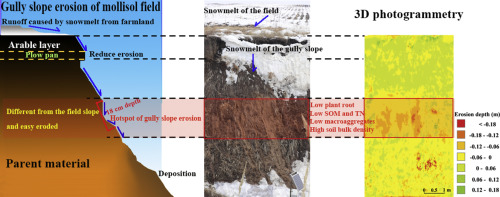当前位置:
X-MOL 学术
›
Sci. Total Environ.
›
论文详情
Our official English website, www.x-mol.net, welcomes your
feedback! (Note: you will need to create a separate account there.)
Quantitative studies of gully slope erosion and soil physiochemical properties during freeze-thaw cycling in a Mollisol region.
Science of the Total Environment ( IF 8.2 ) Pub Date : 2019-12-18 , DOI: 10.1016/j.scitotenv.2019.136191 Shaoliang Zhang 1 , Xinrui Wang 1 , Ziliang Xiao 1 , Fengjuan Qu 1 , Xueshan Wang 1 , Yu Li 1 , Muhammad Aurangzeib 1 , Xingyi Zhang 2 , Xiaobing Liu 2
Science of the Total Environment ( IF 8.2 ) Pub Date : 2019-12-18 , DOI: 10.1016/j.scitotenv.2019.136191 Shaoliang Zhang 1 , Xinrui Wang 1 , Ziliang Xiao 1 , Fengjuan Qu 1 , Xueshan Wang 1 , Yu Li 1 , Muhammad Aurangzeib 1 , Xingyi Zhang 2 , Xiaobing Liu 2
Affiliation

|
Gully erosion has been widely studied during the rainy season due to soil loss that seriously reduces arable area and decreases soil quality. However, very few publications have focused on gully slope erosion (GSE) during freeze thaw cycle (FTC). In this study, GSE on both active and stable gullies in Mollisol fields was investigated by 3D-photogrammetry. Soil bulk density (BD), soil moisture (SM), soil temperature (ST), daily maximum difference in soil temperature (MDT), saturated water (SW), field capacity (FC), soil organic carbon (SOC), soil total nitrogen (TN), water-stable soil aggregate (WA), vegetation cover rate (VC), root dry weight (RW), root length (RL), slope length (SL) and slope steepness (SS) were compared before- and after FTCs. The main results are as follows: (1) combined with both front and profile views, 3D photogrammetry can be used to monitor GSE; (2) GSE mainly occurred at the early stage of FTCs (approximately 80%) and was mainly determined by snowmelt of both the gully slope and farmland and was driven by the solar radiation in activity gully; (3) the high ST in surface soil layers (0-5 cm) of active gullies accelerated the GSE; (4) GSE on the active gully slope was 7.3-9.8 times greater than that on the stable gully slopes; (5) the plough pan as the important layer can effectively reduce GSE at upper slope positions in an active gully; (6) low values of VC, BD, SOC, RW, RL and macro-WA and high values of SL, SW and MDT in the middle of the gully slope typically accelerate the GSE; (7) the index SS*SL/VC can be used to predict GSE on Mollisol gully slopes. Generally, GSE was greatest after FTCs compare to the soil loss tolerance in the Mollisol region, especially in the middle slope position of the active gully, and should urgently be controlled.
中文翻译:

莫利索尔地区冻融循环过程中沟坡侵蚀和土壤理化性质的定量研究。
由于土壤流失会严重减少耕地面积并降低土壤质量,因此在雨季对沟壑侵蚀进行了广泛的研究。但是,很少有出版物关注冻融循环(FTC)期间的沟壑侵蚀(GSE)。在这项研究中,通过3D摄影测量法研究了Mollisol田中活动沟谷和稳定沟谷的GSE。土壤容重(BD),土壤湿度(SM),土壤温度(ST),土壤温度(MDT),饱和水(SW),田间持水量(FC),土壤有机碳(SOC),土壤总量的每日最大差异比较了氮素(TN),水稳性土壤团聚体(WA),植被覆盖率(VC),根部干重(RW),根部长度(RL),坡度长度(SL)和坡度陡度(SS)在FTC之后。主要结果如下:(1)结合前视图和纵断面图,3D摄影测量法可用于监控GSE;(2)GSE主要发生在FTC的早期(约80%),主要由沟渠坡地和农田的融雪决定,并受活动沟渠中太阳辐射的驱使。(3)活动沟壑的表土层(0-5厘米)中较高的ST促进了GSE;(4)活动沟坡的GSE比稳定沟坡的GSE高7.3-9.8倍;(5)犁pan为重要层,可有效降低主动沟中上坡位置的谷胱甘肽过氧化物(GSE);(6)在沟渠中部的VC,BD,SOC,RW,RL和macro-WA的值较低,而SL,SW和MDT的值较高,通常会加速GSE;(7)指数SS * SL / VC可用于预测莫利索尔沟壑坡度的GSE。一般来说,
更新日期:2019-12-18
中文翻译:

莫利索尔地区冻融循环过程中沟坡侵蚀和土壤理化性质的定量研究。
由于土壤流失会严重减少耕地面积并降低土壤质量,因此在雨季对沟壑侵蚀进行了广泛的研究。但是,很少有出版物关注冻融循环(FTC)期间的沟壑侵蚀(GSE)。在这项研究中,通过3D摄影测量法研究了Mollisol田中活动沟谷和稳定沟谷的GSE。土壤容重(BD),土壤湿度(SM),土壤温度(ST),土壤温度(MDT),饱和水(SW),田间持水量(FC),土壤有机碳(SOC),土壤总量的每日最大差异比较了氮素(TN),水稳性土壤团聚体(WA),植被覆盖率(VC),根部干重(RW),根部长度(RL),坡度长度(SL)和坡度陡度(SS)在FTC之后。主要结果如下:(1)结合前视图和纵断面图,3D摄影测量法可用于监控GSE;(2)GSE主要发生在FTC的早期(约80%),主要由沟渠坡地和农田的融雪决定,并受活动沟渠中太阳辐射的驱使。(3)活动沟壑的表土层(0-5厘米)中较高的ST促进了GSE;(4)活动沟坡的GSE比稳定沟坡的GSE高7.3-9.8倍;(5)犁pan为重要层,可有效降低主动沟中上坡位置的谷胱甘肽过氧化物(GSE);(6)在沟渠中部的VC,BD,SOC,RW,RL和macro-WA的值较低,而SL,SW和MDT的值较高,通常会加速GSE;(7)指数SS * SL / VC可用于预测莫利索尔沟壑坡度的GSE。一般来说,















































 京公网安备 11010802027423号
京公网安备 11010802027423号